Curate, connect, and discover
BLACK HOLE - Blog Posts
My brother! I sing for you, for your song shall be heard.
I sing for the billions of years you have sung, and sing for billions more.
May you sing for all the stars and planets who bow to you, and sing for all the light and dark that fear you. Sing, and may the universe be better because of it.

poetry from ny times
Gravitational Waves in the Space-Time Continuum
Einstein's Theories of Relativity
Einstein has two theories of relativity. The first is The Theory of Special Relativity (1905). This is a theory of mechanics that correctly describes the motions of objects moving near the speed of light. This theory predicts that mass increases with velocity. The equation is E=MC^2 or Energy = Mass × Speed of Light ^2.
In 1916, Einstein proposed the Theory of General Relativity, which generalized his Theory of Special Relativity and had the first predictions of gravitational waves. It implied a few things.
Space-Time is a 4-Dimensional continuum.
Principle of equivalence of gravitational and inertial mass.
This suggests that Mass-Energy distorts the fabric of space-time in a predictable way (gravitational waves). It also implies
Strong gravitational force makes time slow down.
Light is altered by gravity
Gravity in strong gravitational fields will no longer obey Newton's Inverse-Square Law.
What is Newton's Inverse-Square Law?
Newton's Inverse-Square Law suggests that the force of gravity between any two objects is inversely proportional to the square of the separation distance between the two centers.
Stephen Hawking's Theory of Everything
Stephen Hawking's Theory of Everything is the solution to Einstein's equation in his Theory of General Relativity. It says that the mass density of the universe exceeds the critical density.
Critical Density: amount of mass needed to make a universe adopt a flat geometry.
This theory states that when the universe gets too big it will crash back into its center in a "Big Crunch" creating giant black hole. The energy from this "Big Crunch" will rebound and create a new "Big Bang".
Big Crunch: hypothetical scenario for the end of the known universe. The expansion of the universe will reverse and collapse on itself. The energy generated will create a new Big Bang, creating a new universe.
Big Bang: Matter will expand from a single point from a state of high density and matter. This will mark the birth of a new universe.
Basic Facts about Gravitational Waves
Invisible "ripples" in the Space-Time Continuum
Travel at the speed of light
186,000 miles per second / 299,337.984 Kilometers per second
11,160,000 miles per minute / 17,960,279.04 Kilometers per minute
669,600,000 miles per hour / 1,077,616,742.4 Kilometers per hour
There are four (4) defined categories
Continuous
Stochastic
Burst
Compact Binary Inspiral
What is LIGO?
The first proof of the existence of gravitational waves came in 1974. 20+ years after Einstein's death.
The first physical proof came in 2015, 100 years after his theory was published. The waves were detected by LIGO.
LIGO- Laser Interferometer Gravitational-Wave Observatory
The waves detected in 2015 came from 2 black holes that collided 1.3 billion years ago in the constellation Hydra. 1.3 billion years ago multicellular life was just beginning to spread on Earth, it was before the time of the dinosaurs!
Continuous Gravitational Waves
Produced by a single spinning massive object.
Caused by imperfections on the surface.
The spin rate of the object is constant. The waves are come at a continuous frequency.
Stochastic Gravitational Waves
Smalles waves
Hardest to detect
Possibly caused by remnants of gravitational radiation left over from the Big Bang
Could possibly allow us to look at the history of the Universe.
Small waves from every direction mixed together.
Burst Gravitational Waves
Never been detected.
Like ever.
Never ever.
Not once.
Nope
No
N E V E R
We don't know anything about them.
If we learn about them they could reveal the greatest revolutionary information about the universe.
Compact Binary Inspiral Gravitational Waves
All waves detected by LIGO fall into this category.
Produced by orbiting pairs of massive and dense objects. (Neutron Stars, Black Holes)
Three (3) subclasses
Binary Neutron Star (BNS) // Two (2) Neutron Stars colliding
Binary Black Hole (BBH) // Two (2) Black Holes colliding
Neutron Star- Black Hole Binary (NSBH) // A black hole and a neutron star colliding
Each subclass creates its own unique wave pattern.
Waves are all caused by the smae mechanism called an "inspiral".
Occur over millions of years.
Over eons the objects orbit closer together.
The closer they get, the faster they spin.
Sources Used:
On The Shoulders Of Giants by Stephen Hawking
Oxford Astronomy Encyclopedia



@watch-out-idiot-passing-through @nasa

What is casting dark shadows across 36,000 light-years of space in this Hubble Space Telescope image?
The mysterious dark rays appearing to emanate from galaxy IC 5063 have intrigued astronomers, and there are a few different ideas about what is causing them. They could be like the shadows of clouds when light from the setting Sun pierces through them.
Astronomers have traced the rays back to the galaxy’s core, the location of an active supermassive black hole. One idea suggests that the shadows are being cast into space by an inner tube-shaped ring, or torus, of dusty material surrounding the black hole.
Credit: NASA, ESA, and W.P. Maksym (CfA).
ALT TEXT: Rust-colored view of space, with a bright, narrow purple region at the center, a galaxy. Background stars and galaxies are scattered sparsely—this is a dusty rather than starry scene. To the upper left of the bright central region are dark dust lanes. Opposite these to the lower right, one dark area extends from the central bright region and splits into two dark rays. Similar dark rays can be seen to the top left, behind the dust lanes. The edges of the entire image are dark, fading from the colored center.
Há quatro anos nessa mesma data (10/04/2019), os cientistas da NASA divulgavam a primeira foto oficial de um Buraco Negro

Imagine being this beautiful:


They are the sh*t, and they know it.



Black Hole Image Makes History; NASA Telescopes Coordinated Observations
A black hole and its shadow have been captured in an image for the first time, a historic feat by an international network of radio telescopes called the Event Horizon Telescope (EHT). EHT is an international collaboration whose support in the U.S. includes the National Science Foundation.
A black hole is an extremely dense object from which no light can escape. Anything that comes within a black hole’s “event horizon,” its point of no return, will be consumed, never to re-emerge, because of the black hole’s unimaginably strong gravity. By its very nature, a black hole cannot be seen, but the hot disk of material that encircles it shines bright. Against a bright backdrop, such as this disk, a black hole appears to cast a shadow.
The stunning new image shows the shadow of the supermassive black hole in the center of Messier 87 (M87), an elliptical galaxy some 55 million light-years from Earth. This black hole is 6.5 billion times the mass of the Sun. Catching its shadow involved eight ground-based radio telescopes around the globe, operating together as if they were one telescope the size of our entire planet.
“This is an amazing accomplishment by the EHT team,” said Paul Hertz, director of the astrophysics division at NASA Headquarters in Washington. “Years ago, we thought we would have to build a very large space telescope to image a black hole. By getting radio telescopes around the world to work in concert like one instrument, the EHT team achieved this, decades ahead of time.”
To complement the EHT findings, several NASA spacecraft were part of a large effort, coordinated by the EHT’s Multiwavelength Working Group, to observe the black hole using different wavelengths of light. As part of this effort, NASA’s Chandra X-ray Observatory, Nuclear Spectroscopic Telescope Array (NuSTAR) and Neil Gehrels SwiftObservatory space telescope missions, all attuned to different varieties of X-ray light, turned their gaze to the M87 black hole around the same time as the Event Horizon Telescope in April 2017. If EHT observed changes in the structure of the black hole’s environment, data from these missions and other telescopes could be used to help figure out what was going on.
While NASA observations did not directly trace out the historic image, astronomers used data from NASA’s Chandra and NuSTAR satellites to measure the X-ray brightness of M87’s jet. Scientists used this information to compare their models of the jet and disk around the black hole with the EHT observations. Other insights may come as researchers continue to pore over these data.
There are many remaining questions about black holes that the coordinated NASA observations may help answer. Mysteries linger about why particles get such a huge energy boost around black holes, forming dramatic jets that surge away from the poles of black holes at nearly the speed of light. When material falls into the black hole, where does the energy go?
“X-rays help us connect what’s happening to the particles near the event horizon with what we can measure with our telescopes,” said Joey Neilsen, an astronomer at Villanova University in Pennsylvania, who led the Chandra and NuSTAR analysis on behalf of the EHT’s Multiwavelength Working Group.
NASA space telescopes have previously studied a jet extending more than 1,000 light-years away from the center of M87. The jet is made of particles traveling near the speed of light, shooting out at high energies from close to the event horizon. The EHT was designed in part to study the origin of this jet and others like it. A blob of matter in the jet called HST-1, discovered by Hubble astronomers in 1999, has undergone a mysterious cycle of brightening and dimming.
Chandra, NuSTAR and Swift, as well as NASA’s Neutron star Interior Composition Explorer (NICER) experiment on the International Space Station, also looked at the black hole at the center of our own Milky Way galaxy, called Sagittarius A*, in coordination with EHT.
Getting so many different telescopes on the ground and in space to all look toward the same celestial object is a huge undertaking in and of itself, scientists emphasize.
“Scheduling all of these coordinated observations was a really hard problem for both the EHT and the Chandra and NuSTAR mission planners,” Neilsen said. “They did really incredible work to get us the data that we have, and we’re exceedingly grateful.”
Neilsen and colleagues who were part of the coordinated observations will be working on dissecting the entire spectrum of light coming from the M87 black hole, all the way from low-energy radio waves to high-energy gamma rays. With so much data from EHT and other telescopes, scientists may have years of discoveries ahead.
Original article:
http://nasa.gov/mission_pages/chandra/news/black-hole-image-makes-history
Time And Space
Gamma-ray Bursts: Black Hole Birth Announcements
Gamma-ray bursts are the brightest, most violent explosions in the universe, but they can be surprisingly tricky to detect. Our eyes can’t see them because they are tuned to just a limited portion of the types of light that exist, but thanks to technology, we can even see the highest-energy form of light in the cosmos — gamma rays.
So how did we discover gamma-ray bursts?
Accidentally!

We didn’t actually develop gamma-ray detectors to peer at the universe — we were keeping an eye on our neighbors! During the Cold War, the United States and the former Soviet Union both signed the Nuclear Test Ban Treaty of 1963 that stated neither nation would test nuclear weapons in space. Just one week later, the US launched the first Vela satellite to ensure the treaty wasn’t being violated. What they saw instead were gamma-ray events happening out in the cosmos!

Things Going Bump in the Cosmos
Each of these gamma-ray events, dubbed “gamma-ray bursts” or GRBs, lasted such a short time that information was very difficult to gather. For decades their origins, locations and causes remained a cosmic mystery, but in recent years we’ve been able to figure out a lot about GRBs. They come in two flavors: short-duration (less than two seconds) and long-duration (two seconds or more). Short and long bursts seem to be caused by different cosmic events, but the end result is thought to be the birth of a black hole.

Short GRBs are created by binary neutron star mergers. Neutron stars are the superdense leftover cores of really massive stars that have gone supernova. When two of them crash together (long after they’ve gone supernova) the collision releases a spectacular amount of energy before producing a black hole. Astronomers suspect something similar may occur in a merger between a neutron star and an already-existing black hole.

Long GRBs account for most of the bursts we see and can be created when an extremely massive star goes supernova and launches jets of material at nearly the speed of light (though not every supernova will produce a GRB). They can last just a few seconds or several minutes, though some extremely long GRBs have been known to last for hours!

A Gamma-Ray Burst a Day Sends Waves of Light Our Way!
Our Fermi Gamma-ray Space Telescope detects a GRB nearly every day, but there are actually many more happening — we just can’t see them! In a GRB, the gamma rays are shot out in a narrow beam. We have to be lined up just right in order to detect them, because not all bursts are beamed toward us — when we see one it’s because we’re looking right down the barrel of the gamma-ray gun. Scientists estimate that there are at least 50 times more GRBs happening each day than we detect!

So what’s left after a GRB — just a solitary black hole? Since GRBs usually last only a matter of seconds, it’s very difficult to study them in-depth. Fortunately, each one leaves an afterglow that can last for hours or even years in extreme cases. Afterglows are created when the GRB jets run into material surrounding the star. Because that material slows the jets down, we see lower-energy light, like X-rays and radio waves, that can take a while to fade. Afterglows are so important in helping us understand more about GRBs that our Neil Gehrels Swift Observatory was specifically designed to study them!

Last fall, we had the opportunity to learn even more from a gamma-ray burst than usual! From 130 million light-years away, Fermi witnessed a pair of neutron stars collide, creating a spectacular short GRB. What made this burst extra special was the fact that ground-based gravitational wave detectors LIGO and Virgo caught the same event, linking light and gravitational waves to the same source for the first time ever!

For over 10 years now, Fermi has been exploring the gamma-ray universe. Thanks to Fermi, scientists are learning more about the fundamental physics of the cosmos, from dark matter to the nature of space-time and beyond. Discover more about how we’ll be celebrating Fermi’s achievements all year!
Make sure to follow us on Tumblr for your regular dose of space: http://nasa.tumblr.com
Black holes ruled out as universe's missing dark matter
For one brief shining moment after the 2015 detection of gravitational waves from colliding black holes, astronomers held out hope that the universe’s mysterious dark matter might consist of a plenitude of black holes sprinkled throughout the universe.
University of California, Berkeley, physicists have dashed those hopes.

Based on a statistical analysis of 740 of the brightest supernovas discovered as of 2014, and the fact that none of them appear to be magnified or brightened by hidden black hole “gravitational lenses,” the researchers concluded that primordial black holes can make up no more than about 40 percent of the dark matter in the universe. Primordial black holes could only have been created within the first milliseconds of the Big Bang as regions of the universe with a concentrated mass tens or hundreds of times that of the sun collapsed into objects a hundred kilometers across.
The results suggest that none of the universe’s dark matter consists of heavy black holes, or any similar object, including massive compact halo objects, so-called MACHOs.
Keep reading

#sciphy4all #science #physics #photon #black #hole #blackhole #joke

Astrophysicists detect ultra-fast winds near supermassive black hole
New research led by astrophysicists at York University has revealed the fastest winds ever seen at ultraviolet wavelengths near a supermassive black hole.
“We’re talking wind speeds of 20 per cent the speed of light, which is more than 200 million kilometres an hour. That’s equivalent to a category 77 hurricane,” says Jesse Rogerson, who led the research as part of his PhD thesis in the Department of Physics and Astronomy at York U. “And we have reason to believe that there are quasar winds that are even faster.”
Astronomers have known about the existence of quasar winds since the late 1960s. At least one in four quasars have them. Quasars are the discs of hot gas that form around supermassive black holes at the centre of massive galaxies - they are bigger than Earth’s orbit around the sun and hotter than the surface of the sun, generating enough light to be seen across the observable universe.
“Black holes can have a mass that is billions of times larger than the sun, mostly because they are messy eaters in a way, capturing any material that ventures too close,” says York University Associate Professor Patrick Hall, who is Rogerson’s supervisor. “But as matter spirals toward a black hole, some of it is blown away by the heat and light of the quasar. These are the winds that we are detecting.”
Rogerson and his team used data from a large survey of the sky known as the Sloan Digital Sky Survey to identify new outflows from quasars. After spotting about 300 examples, they selected about 100 for further exploration, collecting data with the Gemini Observatory’s twin telescopes in Hawaii and Chile, in which Canada has a major share.
“We not only confirmed this fastest-ever ultraviolet wind, but also discovered a new wind in the same quasar moving more slowly, at only 140 million kilometres an hour,” says Hall. “We plan to keep watching this quasar to see what happens next.”
Much of this research is aimed at better understanding outflows from quasars and why they happen.
“Quasar winds play an important role in galaxy formation,” says Rogerson. “When galaxies form, these winds fling material outwards and deter the creation of stars. If such winds didn’t exist or were less powerful, we would see far more stars in big galaxies than we actually do.”
The team’s findings were published today in the print edition of the Monthly Notices of the Royal Astronomical Society.

Question: If 2 black holes get near each other, can they then gravitationally pull matter out of the other black hole & back into “normal” space?
The short answer is no.
A black hole (in the traditional sense) is defined as an object that has collapsed so that its radius is equal to, or less than, the Schwarzschild of the object.
What does this mean?
Every object has a Schwarzschild radius; this is the point at which an object’s mass is so compressed that the gravitational influence overpowers the other forces of nature and it collapses to a singularity.
Of course, not every object is massive enough to collapse to its Schwarzschild radius. The Earth’s Schwarzschild radius, for example, is about the diameter of a small marble. If you were to apply enough energy to the Earth and compress its mass to that size, it would collapse to form a black hole. The same is true for humans, except I’d need to compress you to a point some 10-million times smaller than a marble in order to turn you into a black hole.
So, what is special about the Schwarzschild radius? This is the point at which the escape velocity for the object is equal to the speed of light. Obviously, since you can’t travel ,or faster than, the speed of light you can’t get out of a black hole neither can another black hole pull you out.
It’s important to realize that, outside of the Schwarzschild radius (also known as the event horizon), spacetime is normal. You can interact with a black hole in the same ways you interact with any other object of mass.
Image credit: NASA/CXC/A.Hobart
Article: From Quarks to Quasars
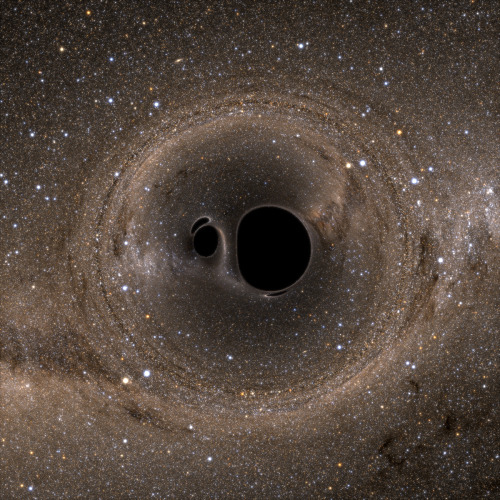
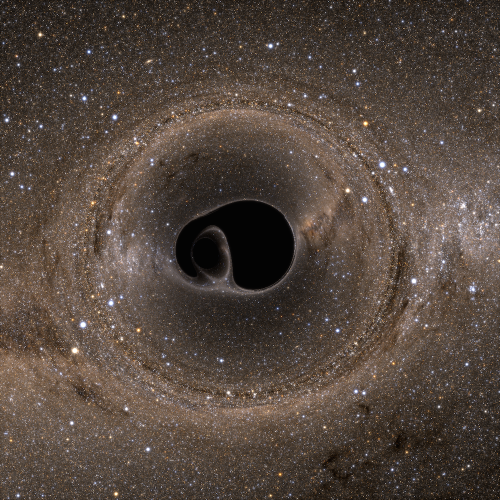
A Black Hole is an extraordinarily massive, improbably dense knot of spacetime that makes a living swallowing or slinging away any morsel of energy that strays too close to its dark, twisted core. Anyone fortunate (or unfortunate) enough to directly observe one of these beasts in the wild would immediately notice the way its colossal gravitational field warps all of the light from the stars and galaxies behind it, a phenomenon known as gravitational lensing.
Thanks to the power of supercomputers, a curious observer no longer has to venture into outer space to see such a sight. A team of astronomers has released their first simulated images of the lensing effects of not just one, but two black holes, trapped in orbit by each other’s gravity and ultimately doomed to merge as one.
http://www.universetoday.com/116500/new-simulation-offers-stunning-images-of-black-hole-merger/?









Black Hole Caught Devouring Star For An Entire Decade
“Normally lasting weeks or months, a new record has just been set for TDEs. XJ1500+0154, 1.8 billion light years away, is the largest, longest-lasting one ever seen. First detected in July of 2005, the X-rays from this distant source brightened by a factor of 100 over 3 years. They remain bright even today. Although dozens of TDEs have been observed since the 1990s, none have lasted this long. It may be caused by the most massive star ever observed creating a TDE.”
When any object passes too close to the event horizon of a black hole, the tidal forces acting on it can become so strong that they’ll tear the entire object apart in a spaghettification disaster. While most of the matter will get ejected from the encounter, a significant fraction can be accreted, absorbed and used to fuel the black hole’s growth. These tidal disruption events have been seen numerous times since the launch of our X-ray observatories, and are now known to come in a wide variety of magnitudes, at a variety of distances and to last a variable amount of time. So when you see the largest, longest-lasting one ever, you sit up and take notice! That’s exactly what’s happened with XJ1500+154, which is now in its second decade of X-ray signals.
Come get the full story on this amazing object, and learn how it might solve the puzzle of supermassive black hole growth on today’s Mostly Mute Monday!
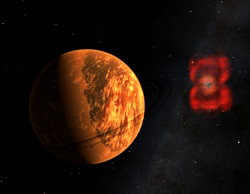
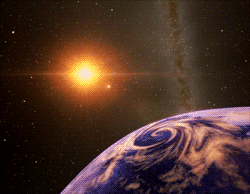
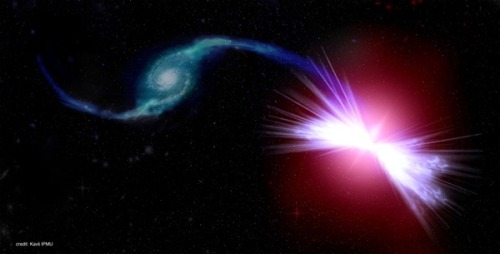
Afraid of Global Warming? Well, now there’s Galactic Warming from our dear friends, those super-massive black holes lurking just about everywhere a galaxy has sprouted up.
These wacky systems are so extreme as to completely skip out of many generations of new stars, leaving a severe stellar age gap in these galaxies, given an entirely new class called “red geysers”.
[First two images are gifs from “Space Engine”, the second is a rendering of the red geyser Akira galaxy sapping off of Tetsuo, it’s neighbor ]

WOW!!
This computer-simulated image shows a supermassive black hole at the core of a galaxy. The black region in the center represents the black hole’s event horizon, where no light can escape the massive object’s gravitational grip. The black hole’s powerful gravity distorts space around it like a funhouse mirror. Light from background stars is stretched and smeared as the stars skim by the black hole.
Credits: NASA, ESA, and D. Coe, J. Anderson, and R. van der Marel (STScI)
Full Story at Hubble Space Telescope/NASA.- Behemoth Black Hole Found in an Unlikely Place
High-res images at HubbleSite.org




UU: it is the day whereafter the legendary octet of mUtUal progenitoriety will come together and heal a great breach in paradox space. UU: a day delivered throUgh eighty billion years and foUr distinct Universal instances worth of Unfathomable tUrbUlence. UU: and while the emerald eye of this storm is fixed in the abyss forever UU: today yoU are poised to escape its scowl once and for all. UU: by skaias gUiding light, yoU may leave behind its tUrning arms of bright coloUrs and mayhem, and secUre peace for yoUr cosmic progeny for all dUration.
The emerald eye of the storm---the storm of “Unfathomable tUrbUlence“ and “a great breach in paradox space“!
The song “Eternity, Served Cold” plays in both [S] Caliborn: Enter and [S] Collide. There is some overlap, but the first half of the song plays in the former, and the second half in Collide.
[S] Caliborn: Enter ends here:


And in [S] Collide, when the rest of the song begins to play, it starts here:


This has to be intentional and significant.
Suddenly this seems extremely relevant:
TT: But I'm confident in my plan. I have it under control. GA: Your Hubris Is Really Astonishing GA: Easily Twice The Mass Of A Universe I Think GA: That It Hasnt Collapsed Upon Itself Into A Tiny Lavender Singularity Is The Most Striking Marvel Paradox Space Has Coughed Up Yet TT: Maybe it did? TT: Maybe that's what went wrong. TT: We figured it out!
Hey, remember that time two Kernelsprites prototyped each other?

Remember how that basically created a black hole that sucked in an entire planet?

Remember that other time two sprites prototyped each other?


Hubble classic view of Orion nebula🌌

Trou noir (IV), accès à une casemate, Bayonne, Pyrénées -Atlantiques (France)
Une casemate, appelée blockhaus (en allemand) ou bunker (en anglais), est un local, souvent partiellement enterré, d'un système fortifié, Dans les remparts de la ville de Bayonne : Les casemates sont des lieux creusés jadis et dédiés à la guerre, elles servaient de point de tirs pour protéger la ville. Désormais elles sont occupées et entretenues par des associations dédiées aux sports, à la musique, au chant, où s’y déroulent leurs réunions, leurs fêtes, etc
A small shelter for soldiers, often partly underground, from which a gun can be fired
Dany ERDOCIO

"Trou noir" (II) Chapeau de coulemelle
Dany ERDOCIO

While everyone draws beautiful girls, my brain generates something unhuman and strange

Supermassive Black Hole
